The sprawling Hofburg complex was the bastion of the Habsburg monarchs, who ruled over Austria – and at times many other regions of Europe – for more than six centuries, from 1276 until the downfall of the Habsburgs in 1918.
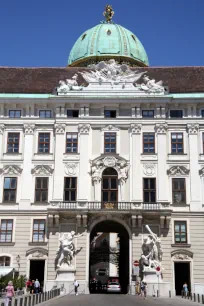
Today the Hofburg (Court Palace) is a tourist magnet, and visitors flock to see the royal apartments, chapel, church, library, the Winterreitschule and the many museums that are housed in the complex, which consists of eighteen wings with more than two thousand rooms designed in a wide range of architectural styles, from Gothic to Baroque and Neoclassicist. The mostly Baroque exterior is nonetheless surprisingly harmonious.
Due to its vast size it is impossible to visit all the attractions in the Hofburg in just one day. Some of the highlights include the Kaiserappartements (royal apartments), the Schatzkammer (Treasury), the Prunksaal in the National Library, the Winterreitschule (Winter riding school), the Albertina Museum and the Neue Burg museums.
History
Construction of the Hofburg did not start with the Habsburgs, but with King Ottokar II of Bohemia, who was also the Duke of Austria. In 1275 he had a fortress built at the site of current Schweizerhof, a rectangular structure with four towers. After Rudolf I, the first of the Habsburg dynasty, ousted Ottokar II in 1276, he expanded the fortress. Today, there are no visible traces of this original structure left.
Alte Hofburg
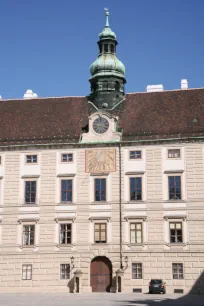
Construction of the complex we know today started after 1533, when Ferdinand I decided to move his main residence to Vienna, making it the capital of the Holy Roman Empire. Construction of what is now known as the Alte Hofburg, was completed in 1552. The Schweizertor, the gate that leads to the Alte Hofburg, was built the following year. Ferdinand’s son, Maximilian II, added the Stallburg to the complex.
Amalienburg
Maximilian’s son, Rudolf, decided he wanted his own palace and built the Amalienburg, detached from the existing structure. A courtyard, now known as the Innenhof or In der Burg separated the two palaces.
Leopoldinischertrakt
The Thirty Years’ War caused a pause in construction activity, but in 1660 the expansion of the Hofburg continued with the construction of the Leopoldinischertrakt (Leopold Wing) by Emperor Leopold I. This new wing connected Amalienburg with Alte Hofburg. Construction accelerated after the landmark victory over the Turkish in 1683.
The official court architect, Joseph Emanuel Fischer von Erlach, designed the magnificent court library, the Winter Riding school, and the Reichkanzleitrakt. He also designed Michaelertrakt, a Baroque wing which was only completed centuries later.
Neue Burg and Heldenplatz
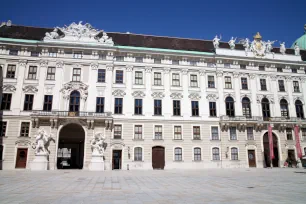
Another building frenzy started at the end of the nineteenth century, a time when the Habsburg monarchy started to show signs of decline. During Emperor Franz-Joseph’s reign from 1848 until 1916, the most recent additions to the complex were built including the Michaelertrakt – a wing with a monumental gate, the Michaelertor – and the Neue Burg, an enormous wing with a curved facade, facing Heldenplatz. Neue Burg was just a part of an ambitious project to build a new Kaiserforum, an imperial forum which would have connected Hofburg with the museum complex across the Ringstraße via a series of triumphal arches. Alas, the outbreak of the First World War halted new construction.
A mirroring wing opposite Neue Burg and the connecting arches were never realized.
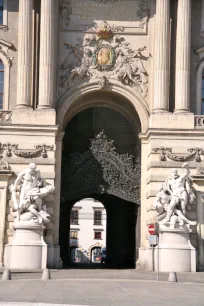
Despite spending fortunes on the construction of the Hofburg, the Habsburg rulers rarely resided in the palace complex, especially after the Schönbrunn Palace was constructed in the eighteenth century. The palace was mainly used for official obligations and meetings with foreign dignitaries.
Touring the Palace
The most common way to enter the Hofburg is from Michaelerplatz. An ornate Baroque gateway, the Michalertor, connects the square with a large courtyard, the In der Burg, sometimes also referred to as the Innenhof. The monumental gateway is decorated with expressive statues of Hercules. Inside the wide passageway are entrances to some of the most famous attractions in the Hofburg: the Winterreitschule (Winter Riding School) on the left and the Kaiserappartements (apartments of the emperor) to the right.
Innenhof
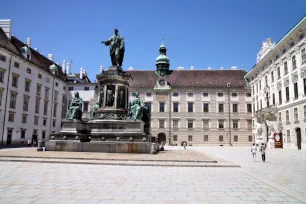
Entering the courtyard, you can see the Alte Burg – the oldest part of the Hofburg complex – on the left and Amalienburg – a Renaissance palace with a clock tower – on the right hand side. The Leopoldinischer Trakt (Leopold Wing) is straight ahead and opposite is the Reichskanzleitrakt, ornately decorated with monumental sculptures (The Labors of Hercules) created by Lorenzo Mattielli. The central door in the Reichkanzleitrakt leads to the Kaisersappartementen and the Sissi Museum, one of the Hofburg’s most popular attractions.
At the center of the courtyard – originally a parade ground – is a large monument dedicated to Emperor Francis I of Austria a.k.a. Francis II, Holy Roman Emperor. The large monument was created in 1824-1846 by the Italian sculptor Pompeo Marchesi. The monument shows the emperor in classical Roman attire set atop a tall plinth, surrounded by four other statues.
Schweizerhof
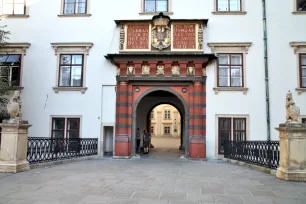
The emperor looks in the direction of the Schweizertor, an old gate which leads to Schweizerhof (Swiss Court), the inner courtyard of the oldest part of the imperial palace. Its name is derived from the Swiss guards who were hired in the eighteenth century to protect the monarchs. Bordering Schweizerhof is Burgkapelle, a small chapel decorated in Baroque style. It is famous for the Wiener Sängerknaben (Vienna Boy Choir), who perform here on a regular basis. Another attraction at the small courtyard is the Schatzkammer (Treasury), a museum with a collection that will even impress the most museum-averse visitors.
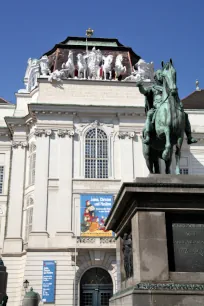
Josefsplatz
An archway connects Schweizerhof with Josefsplatz, a square graced with a statue of Joseph II, created in 1807 by Franz Anton Zauner. Behind the statue is the Prunksaal, a monumental Baroque room. It is easily the most impressive room of the National Library, which is spread out over the Hofburg.
Following Augustinerstraße from Josefsplatz brings you past the Augustinerkirche, which was originally built in the fourteenth century as the church of a monastery, but became enveloped by the encroaching Hofburg complex. In 1634 it officially became the royal parish church. Inside you’ll find a magnificent Gothic interior. Further south along Augustinerstraße is Albertina, a palace built in the eighteenth century atop the Augustinian bastion.
Neue Burg
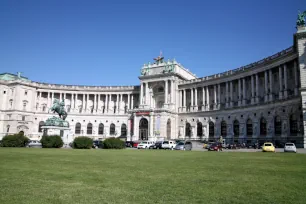
The most recent part of the Hofburg is the Neue Burg, an imposing wing built between 1881 and 1913 after designs by Gottfried Semper. It can be accessed from the Heldenplatz which is reached via a gate through the Leopold Wing coming from the Hofburg or via the Ringstraße. Neue Burg is not only home to a number of museums but also contains the main reading room of the National Library.
Museums and other attractions
Kaiserappartements
There’s no shortage of things to see in the Hofburg, and most visitors to Vienna spend a large part of their visit inside any of the more than two thousand rooms of the complex. A favorite is a tour along the Kaiserappartements, the imperial apartments. Before you enter the apartments you can also tour the Silberkammer – a silver museum – and the Sissi Museum, an exhibition on the most popular of all the Habsburg empresses. There are two entrances to the museums, one at the large inner courtyard and another one in the gateway through the Michaelertrakt.
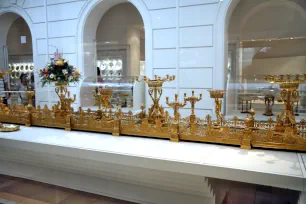
An impressive collection of silverware and golden and porcelain items are on display on the ground floor in the Silberkammer. The museum’s piece de resistance is a gilded bronze table-centerpiece which stretches more than ten meters long.
The Sissi Museum shows memorabilia, dresses, portraits and other items related to Empress Elisabeth, who is affectionately known as Sissi. She was married to Emperor Franz-Joseph but became estranged and traveled across Europe for much of her life until she was killed in Geneva by an Italian anarchist in 1898.
Exiting the Sissi Museum you enter the apartments of Franz-Joseph, where the emperor used to spend much of his time. These apartments are modestly decorated, in line with the emperor’s frugal reputation. Adjoining are the apartments of empress Elisabeth, including the bedroom, dressing room and exercise room, complete with wooden exercise equipment. Following are a number of rooms named after Tsar Alexander I, who stayed here during the Congress of Vienna in 1815. Of note is the dining room, laid out as it was during the era of Emperor Franz Joseph.
Schatzkammer
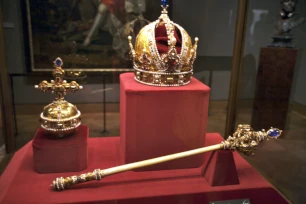
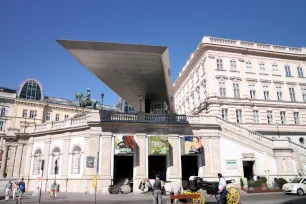
Even more impressive than the luxury displayed in the Kaiserappartements is the Schatzkammer, a museum with an awesome display of crowns, scepters and other powerful (and expensive) symbols of the Holy Roman Empire. Highlights include the imperial crown of Emperor Rudolph II, studded with countless gems and the crown jewels of the Holy Roman Empire, with an octagonal imperial crown. There are also a number of curiosities in the Schatzkammer, such as a long horn from a unicorn and a relic of the Holy Cross. The Schatzkammer‘s entrance is at Schweizerhof, the oldest part of the Hofburg.
For a totally different museum, head to the southernmost corner of the Hofburg, where you’ll find the Albertina, a museum with an important collection of aquarelles, illustrations, etches, drawings and photos. It is housed in a palace that was once owned by Duke Albert of Saxony-Teschen after whom the museum is named.
Neue Hofburg Museums
More museums can be found in the Neue Hofburg, a large wing with curved facade at the Heldenplatz. The Ephesos museum showcases the results of the excavations of an archaeological site in Ephesos, Turkey. The Sammlung alter Musikinstrumente has an interesting collection of historic musical instruments, such as a violin decorated with gold and ivory. The Weltmuseum (Museum of Ethnology) displays a collection of historic artifacts from the Americas, Asia, Oceania, Africa and even Siberia.
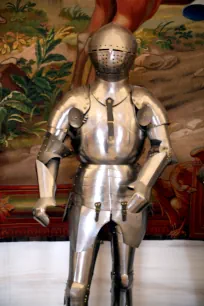
The largest museum in the Neue Burg is the Hofjagd- und Rüstkammer, which showcases an extensive collection with magnificent suits of armor from the fourteenth to the seventeenth centuries.
Spanish Riding School
The Spanische Reitschule (Spanish Riding School) is a popular attraction of the Hofburg that is steeped in history. The famous horse riding school is housed in the purpose-built Winterreitschule (Winter Riding School), an ornately decorated building complete with a series of chandeliers. Visitors can attend one of the performances, but keep in mind that those are often fully booked months in advance. Alternatively, attend one of the training sessions or visit the Lippizaner Museum in the nearby Stallburg (stables). Named after the horses that show off their prowess in the Winterreitschule, the museum displays an array of equestrian-related items. Visitors can also see the Lippizaner horses in their stables.
Wiener Sängerknaben and Prunksaal
Other attractions of the Hofburg include the performances of the Wiener Sängerknaben – a famous boys choir – in the Hofkapelle at the Schweizerhof. An architectural marvel of the Hofburg is the Prunksaal of the National Library, a lavishly decorated, 77-meter-long (253 ft.) hall with a collection of historic books arranged on wooden shelves along the walls. The majestic Prunksaal (Splendour Hall) is true to its name with its monumental columns, fine statues and magnificent ceiling frescoes.
- Next: Belvedere
- More Sights & Attractions in Vienna
